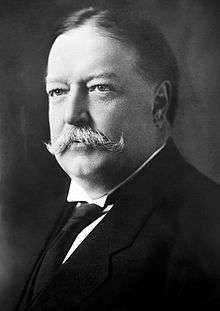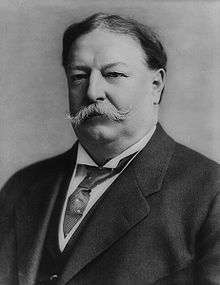1908 United States presidential election
The 1908 United States presidential election was the 31st quadrennial presidential election, held on Tuesday, November 3, 1908. Secretary of War and Republican Party nominee William Howard Taft defeated three-time Democratic nominee William Jennings Bryan.
| |||||||||||||||||||||||||||||
483 members of the Electoral College 242 electoral votes needed to win | |||||||||||||||||||||||||||||
|---|---|---|---|---|---|---|---|---|---|---|---|---|---|---|---|---|---|---|---|---|---|---|---|---|---|---|---|---|---|
| Turnout | 65.4%[1] | ||||||||||||||||||||||||||||
| |||||||||||||||||||||||||||||
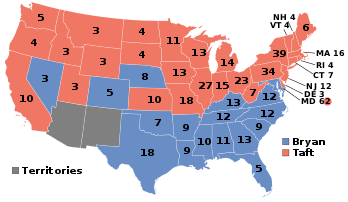  Presidential election results map. Red denotes those won by Taft/Sherman, blue denotes states won by Bryan/Kern. Numbers indicate the number of electoral votes allotted to each state. | |||||||||||||||||||||||||||||
| |||||||||||||||||||||||||||||
Popular incumbent President Theodore Roosevelt honored his promise not to seek a third term, and persuaded his close friend, Taft, to become his successor. With Roosevelt's support, Taft won the presidential nomination of the 1908 Republican National Convention on the first ballot. Having lost the 1904 election badly, the Democratic Party re-nominated Bryan, who had been defeated in 1896 and 1900 by Republican William McKinley. Despite his two previous defeats and the waning of the Free Silver issue, Bryan remained extremely popular among the more liberal and populist elements of the Democratic Party.
Bryan ran a vigorous campaign against the nation's business elite, but the Democrat suffered the worst loss of his three presidential campaigns. Taft won 51.6% of the popular vote and carried most states outside of the Solid South. Taft's triumph gave Republicans their fourth straight presidential election victory. Two third party candidates, Eugene V. Debs of the Socialist Party and Eugene W. Chafin of the Prohibition Party, each took over 1% of the popular vote.
Nominations
Republican Party nomination
Nominees
| Republican Party Ticket, 1908 | |||||||||||||||||||||||||||||
| William Howard Taft | James S. Sherman | ||||||||||||||||||||||||||||
|---|---|---|---|---|---|---|---|---|---|---|---|---|---|---|---|---|---|---|---|---|---|---|---|---|---|---|---|---|---|
| for President | for Vice President | ||||||||||||||||||||||||||||
 |
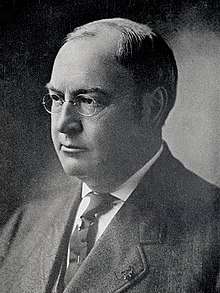 | ||||||||||||||||||||||||||||
| 42nd U.S. Secretary of War (1904–1908) |
U.S. Representative for New York's 27th (1903–1909) | ||||||||||||||||||||||||||||
| Campaign | |||||||||||||||||||||||||||||
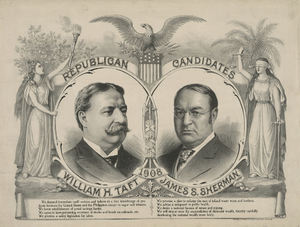 | |||||||||||||||||||||||||||||
Candidates
| Candidates in this section are sorted by delegates won | |||||||
| William H. Taft | Philander C. Knox | Charles E. Hughes | Joseph G. Cannon | Charles W. Fairbanks | Robert M. La Follette | Joseph B. Foraker | Leslie M. Shaw |
|---|---|---|---|---|---|---|---|
 |
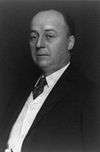 |
 |
 |
.jpg) |
 |
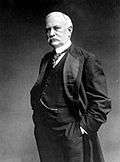 |
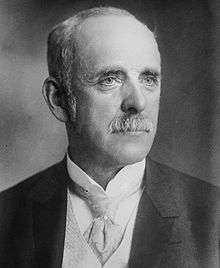 |
| 42nd U.S. Secretary of War from Ohio (1904–1908) |
44th U.S. Attorney General from Pennsylvania (1901–1904) |
36th Governor of New York (1907–1910) |
35th House Speaker from Illinois (1903–1911) |
26th U.S. Vice President from Indiana (1905–1909) |
U.S. Senator from Wisconsin (1906–1925) |
U.S. Senator from Ohio (1897–1909) |
43rd U.S. Secretary of the Treasury from Iowa (1902–1907) |
| Delegates: 549 [2][2][3][4][5][6] | Delegates: 67 [2][6] | Delegates: 54 [2][6] | Delegates: 46 [2][6] | Delegates: 32 [2][6] | Delegates: 25 [2][6] | Delegates: 5 [2][7][6] | Delegates: 0 [2] |
| Campaign | Campaign | Campaign | |||||
The Republican nomination contest marked the introduction of the presidential preference primary. The idea of the primary to nominate candidates was sponsored by anti-machine politicians such as New York Governor Charles Evans Hughes and Senator Albert B. Cummins. The first state to hold a presidential primary to select delegates to a national convention was Florida in 1904, when Democratic Party voters held a primary among uninstructed candidates for delegate. Early in 1908, the only two Republican contenders running nationwide campaigns for the presidential nomination were Secretary of War William Howard Taft and Governor Joseph B. Foraker, both of Ohio. In the nomination contest, four states held primaries to select national convention delegates. In Ohio, the state Republican Party held a primary on February 11. Candidates pledged to Taft were printed on the ballot in a Taft column, and candidates pledged to Foraker were printed in a column under his name. Taft won a resounding victory in Ohio. The three states holding primaries to select delegates without the preference component were split: California chose a slate of delegates that supported Taft; Wisconsin elected a slate that supported Wisconsin Senator Robert M. La Follette, Sr., and Pennsylvania elected a slate that supported its Senator Philander C. Knox.
The 1908 Republican Convention was held in Chicago between June 16 and 19. William Howard Taft was nominated with 702 votes to 68 for Knox, 67 for Hughes, 58 for Cannon, 40 for Fairbanks, 25 for La Follette, 16 for Foraker, 3 for President Roosevelt, and one abstention.[8]
| Presidential Ballot | ||
| Candidate | 1st | Unanimous |
| William Howard Taft | 702 | 980 |
|---|---|---|
| Philander C. Knox | 68 | - |
| Charles Evans Hughes | 67 | - |
| Joseph Gurney Cannon | 58 | - |
| Charles W. Fairbanks | 40 | - |
| Robert M. La Follette Sr. | 25 | - |
| Joseph B. Foraker | 16 | - |
| Theodore Roosevelt | 3 | - |
| Not Voting | 1 | - |
Representative James S. Sherman from New York received the vice-presidential nomination.
| Vice-Presidential Ballot | ||
| Candidate | 1st | Unanimous |
| James S. Sherman | 816 | 980 |
|---|---|---|
| Franklin Murphy | 77 | - |
| Curtis Guild, Jr. | 75 | - |
| George L. Sheldon | 10 | - |
| Charles W. Fairbanks | 1 | - |
| Not Voting | 1 | - |
Democratic Party nomination
Nominees
| Democratic Party Ticket, 1908 | |||||||||||||||||||||||||||||
| William Jennings Bryan | John W. Kern | ||||||||||||||||||||||||||||
|---|---|---|---|---|---|---|---|---|---|---|---|---|---|---|---|---|---|---|---|---|---|---|---|---|---|---|---|---|---|
| for President | for Vice President | ||||||||||||||||||||||||||||
.jpg) |
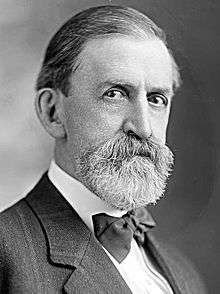 | ||||||||||||||||||||||||||||
| Former U.S. Representative for Nebraska's 1st (1891–1895) |
Former Indiana State Senator (1893–1897) | ||||||||||||||||||||||||||||
| Campaign | |||||||||||||||||||||||||||||
 | |||||||||||||||||||||||||||||
Candidates
| Candidates in this section are sorted by delegates won | ||||||||
| William J. Bryan | John A. Johnson | George Gray | Jesse R. Grant | |||||
|---|---|---|---|---|---|---|---|---|
.jpg) |
 |
 |
.jpg) | |||||
| U.S. Representative for Nebraska's 1st District (1891–1895) |
16th Governor of Minnesota (1905–1909) |
Federal Appeals Judge from Delaware (1899–1914) |
Engineer and Businessman from California | |||||
| Delegates: 549 [11] | Delegates: 25 [11] | Delegates: 6 [11] | Delegates: 0 [11] | |||||
| Campaign | ||||||||
| President | Vice President | ||
|---|---|---|---|
| √ William J. Bryan | 888.5 / Unanimous | √ John W. Kern | Unanimous |
| George Gray | 59.5 | ||
| John A. Johnson | 46 | ||
| Not Voting | 8 | ||
As the 1908 election approached, William Jennings Bryan was the front-runner for the Democratic presidential nomination. Bryan's most formidable challenger for the nomination was Minnesota Governor John Albert Johnson. Johnson's rags-to-riches story, honesty, reformist credentials, and ability to win in a heavily Republican state made him popular within the Democratic Party. In March, the Minnesota Democratic State Convention endorsed Johnson for president. By the end of June, however, Bryan had amassed more than the requisite two-thirds of the delegates needed for nomination.
The 1908 Democratic National Convention was held in Denver between July 7 and 10. Johnson, aware of the fact that Bryan's nomination was a foregone conclusion, released his delegates, thereby allowing Bryan to win the nomination on the first ballot.[12]
Bryan left the choice of vice-president to the delegates. John W. Kern from Indiana was unanimously declared the candidate for vice-president without a formal ballot after the names of Charles A. Towne, Archibald McNeil, and Clark Howell were withdrawn from consideration. Kern was a former state senator (1893-1897) and two-time gubernatorial candidate (1900 and 1904).
In response to nomination of Bryan and Kern, The New York Times disparagingly pointed out that the Democratic national ticket was consistent because "a man twice defeated for the Presidency was at the head of it, and a man twice defeated for governor of his state was at the tail of it."[12]
Third Parties and Independents
People's Party nomination
Nominees
| People's Party Ticket, 1908 | |||||||||||||||||||||||||||||
| Thomas E. Watson | Samuel Williams | ||||||||||||||||||||||||||||
|---|---|---|---|---|---|---|---|---|---|---|---|---|---|---|---|---|---|---|---|---|---|---|---|---|---|---|---|---|---|
| for President | for Vice President | ||||||||||||||||||||||||||||
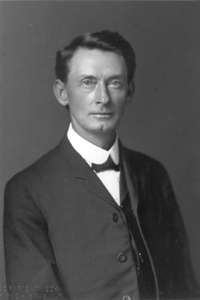 |
 | ||||||||||||||||||||||||||||
| Former U.S. Representative for Georgia's 10th District (1891–1893) |
Former State Representative from Indiana (1885–1887) | ||||||||||||||||||||||||||||
| Campaign | |||||||||||||||||||||||||||||
In 1904 the national Populist Party ticket fared fairly well. Its total was twice the party's total in the previous presidential election, and in ten states, it received over 1% of the vote. It also offered 47 candidates for the House of Representatives, though the only ones elected were cross-endorsed by one of the major parties. The party remained in fusion with either the Democrats or the Republicans in many states.
The following three years were a trying time for the party. When Democrats began to call for the nomination of Bryan in 1908, western Populist leader Thomas Tibbles announced that the People's Party would probably not support him since he had gone into the hands of the Eastern business interests.[13] Two months later, Nebraska Democrats decided in their state convention to end fusion with the Populists, but they changed their mind after an all-night conference.[14] In the midterm elections the party only offered 10 candidates for House, and the Kansas People's Party officially disbanded in December when that state party's leader announced that he was joining the Republicans.[15]
By late 1907, many Populists were hoping that Thomas Watson would agree to run for President again. The previous three years had been unusual for Watson. He gave a speech to a gathering of farmers in Greensborough, Georgia and while preparing for supper, the house where he was staying was burned.[16] In mid-1906, Watson called on Georgia Populists to vote for Hoke Smith for governor in the Democratic primary, which fueled speculation that Watson was thinking of returning to the Democrats.[17] In early 1907, Watson started a network of Populist-leaning publications to keep the party's principles alive; Tibbles was chosen to serve as the chief editor.[18] One month later, someone fired shots into the Watsons' house in Augusta.[19] He had an altercation with an African-American porter on a train; when the porter said that he was unable to increase the train's speed, Watson hit the man in the face with the cap of his cane.[20]
The People's Party National Committee met on November 26, 1907 to make preparations for the 1908 national convention. National chairman James Ferriss indicated that Thomas Watson was the front runner for the nomination, saying that the party hoped to forge an alliance with one or more of the other minor parties, including possibly the Independence League or the Prohibitionists.[21] In early 1908, however, at least one member of the national committee believed that Senator Robert La Follette of Wisconsin would win the Populist nomination.[22]
On the first day of the convention, the delegation from Nebraska worked to adjourn the convention; they had already decided to support Bryan if he became the Democratic nominee. They managed to delay the official organization of the convention all day. One of their delegates, A.M. Walling of Nebraska, told the New York Times "we shall bolt if the convention attempts to nominate Thomas E. Watson, or any one else. We are not alone, for we have assurances that Minnesota, Georgia, and possibly Michigan and Kansas will walk out when we do".[23]
The convention was organized on the second day and completed all its relevant business. Watson supporters chose George A. Honnecker of New Jersey to serve as the permanent chairman, defeating the Bryan supporters' choice, Jacob Coxey. The platform called for inflation of the currency, public ownership of railroads, telephones, and telegraphs, labor legislation, and a ban on futures gambling. When the time for nominations began, a schism took place; Watson's name was placed in nomination, and the Nebraska delegation bolted. They were followed by T.J. Weighan, the sole delegate from Minnesota. Watson was then nominated for President; his running mate was Samuel Williams of Indiana.[24]
Socialist Party nomination
Nominees
| Socialist Party Ticket, 1908 | |||||||||||||||||||||||||||||
| Eugene V. Debs | Benjamin Hanford | ||||||||||||||||||||||||||||
|---|---|---|---|---|---|---|---|---|---|---|---|---|---|---|---|---|---|---|---|---|---|---|---|---|---|---|---|---|---|
| for President | for Vice President | ||||||||||||||||||||||||||||
 |
 | ||||||||||||||||||||||||||||
| Former State Senator from Indiana (1885–1889) |
Printer and Labor Organizer from New York | ||||||||||||||||||||||||||||
| Campaign | |||||||||||||||||||||||||||||
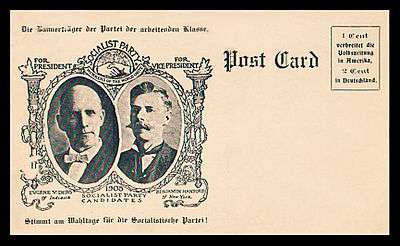 | |||||||||||||||||||||||||||||
Candidates
| Candidates in this section are sorted by convention vote | ||||
| Eugene V. Debs | James F. Carey | Carl D. Thompson | Algie M. Simons | Maximillian S. Hayes |
|---|---|---|---|---|
 |
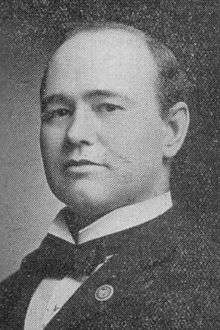 |
 |
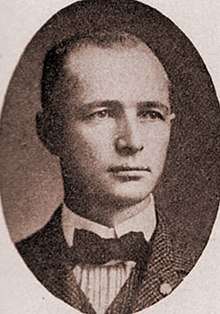 | |
| Former State Senator from Indiana (1885–1889) |
Former State Representative from Massachusetts (1899–1903) |
State Representative from Wisconsin (1906–1908) |
Former Editor of the International Socialist Review from Illinois (1900–1908) |
Editor of the Cleveland Citizen from Ohio (1891–1940) |
| Delegates: 159 | Delegates: 16 DTBN |
Delegates: 14 | Delegates: 9 | Delegates: 0 DTBN |
| [25] | [25] | [25] | [25] | [25] |
Eugene Debs had originally hoped that Bill Haywood, who had attained a national profile from being put on trial for the murder of Frank Steunenberg, of which he was acquitted, would run for the Socialist nomination for president. At this time however the Socialist Party was fracturing between its radical and more moderate elements, and Debs was deemed the only candidate capable of keeping the party unified. He was overwhelmingly nominated for the presidency on the first ballot, with Benjamin Hanford again named as his running-mate.
| President | Vice President | ||
|---|---|---|---|
| √ Eugene V. Debs | 159 / Unanimous | √ Benjamin Hanford | 106 / Unanimous |
| James F. Carey | 16 | Seymour Stedman | 42 |
| Carl D. Thompson | 14 | May W. Simons | 20 |
| Algie M. Simons | 9 | John W. Slayton | 15 |
| Caleb Lipscomb | 1 | ||
| G. W. Woodby | 1 | ||
Socialist Labor Party nomination
Nominees
| Socialist Labor Party Ticket, 1908 | |||||||||||||||||||||||||||||
| August Gillhaus | Donald L. Munro | ||||||||||||||||||||||||||||
|---|---|---|---|---|---|---|---|---|---|---|---|---|---|---|---|---|---|---|---|---|---|---|---|---|---|---|---|---|---|
| for President | for Vice President | ||||||||||||||||||||||||||||
 |
 | ||||||||||||||||||||||||||||
| Engineer from New York |
Machinist from Virginia | ||||||||||||||||||||||||||||
The Socialist Labor Party met in New York, New York from July 2nd to July 5th in Arlington Hall, St. Mark's Place. While increasingly dwarfed by the growing membership of the Socialist Party lead by Eugene Debs and Bill Haywood, Daniel De Leon and his compatriots remained committed to maintaining their separate course, considering Debs and his platform as "reactionary".[26] An attempt was made to depose Leon from his position of editor of the Party's papers in favor of a more moderate candidate, fearing that Leon's writings were alienating voters who might otherwise be sympathetic to their cause. The report was overwhelmingly voted down after Leon spoke in defense of his conduct as the Party's editor, with a rival report being adopted praising his leadership.[27] When it came time for the nominations, Leon personally nominated Martin Preston of Nevada, who was currently serving a twenty-five year sentence for the murder of Anton Silva. While noting that Preston was only 32 at the time, Leon remarked that "it was for the working people to elect Preston, and if he was elected he would be seated". Preston's nomination was ratified unanimously, with Donald Munro of Virginia winning in a contest against Arthur S. Dower of Texas for the Vice Presidential nomination. The nominations were later formalized at Cooper Union following the close of the convention.[28]
Only days later however Martin Preston replied in a telegram that he could not accept the Presidential nomination, a declination that had not been expected nor prepared for.[29] August Gillhaus of New York was later then nominated in Preston's stead.
Prohibition Party nomination
Nominees
| Prohibition Party Ticket, 1908 | |||||||||||||||||||||||||||||
| Eugene W. Chafin | Aaron S. Watkins | ||||||||||||||||||||||||||||
|---|---|---|---|---|---|---|---|---|---|---|---|---|---|---|---|---|---|---|---|---|---|---|---|---|---|---|---|---|---|
| for President | for Vice President | ||||||||||||||||||||||||||||
 |
.jpg) | ||||||||||||||||||||||||||||
| Attorney at Law from Illinois |
Professor and Methodist Minister from Ohio | ||||||||||||||||||||||||||||
| Campaign | |||||||||||||||||||||||||||||
 | |||||||||||||||||||||||||||||
The Prohibition Party met in Columbus, Ohio on July 14th and 15th to nominate their presidential ticket. Eugene Chafin was nominated on the third ballot in an open contest. When the runner-up for the Presidential nomination William Palmore, a Methodist Minister from Missouri and Editor of the St. Louis Christian Advocate, declined his nomination for the Vice Presidency, the convention hurriedly allowed for a new set of nominations and another ballot. Aaron Watkins of Ohio would win a majority on the first ballot.
| President (Note) | Vice President[30] | |||||||
| Candidate | 1st | 2nd | 3rd | Unanimous | Candidate | Unanimous | 1st | Unanimous |
| √ Eugene W. Chafin | 195 | 376 | 636 | 1,087 | √ Aaron S. Watkins | - | ? | 1,087 |
|---|---|---|---|---|---|---|---|---|
| William A. Palmore | 273 | 418 | 415 | - | William A. Palmore | 1,087 | - | - |
| Alfred L. Manierre | 159 | 121 | 4 | - | T. B. Demaree | - | ? | - |
| Daniel R. Sheen | 124 | 157 | 12 | - | Charles S. Holler | - | ? | - |
| Will W. Tracy | 105 | 81 | 7 | - | - | - | - | - |
| Frederick F. Wheeler | 72 | 73 | - | - | - | - | - | - |
| Oliver W. Stewart | 61 | 47 | - | - | - | - | - | - |
| James B. Cranfill | 28 | - | - | - | - | - | - | - |
| George R. Stewart | 7 | - | - | - | - | - | - | - |
| Charles Scanlon | 1 | - | - | - | - | - | - | - |
Independence Party nomination
Nominees
| Independence Party Ticket, 1908 | |||||||||||||||||||||||||||||
| Thomas L. Hisgen | John T. Graves | ||||||||||||||||||||||||||||
|---|---|---|---|---|---|---|---|---|---|---|---|---|---|---|---|---|---|---|---|---|---|---|---|---|---|---|---|---|---|
| for President | for Vice President | ||||||||||||||||||||||||||||
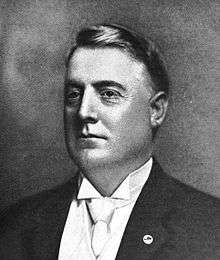 |
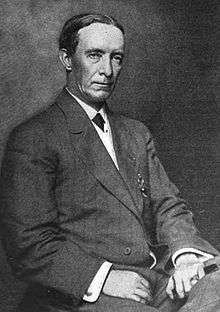 | ||||||||||||||||||||||||||||
| CEO of Hisgen Brothers from Massachusetts (1888–1927) |
Newspaper Editor from Georgia | ||||||||||||||||||||||||||||
Candidates
| Candidates in this section are sorted by highest convention vote | |||||
| Thomas L. Hisgen | John Temple Graves | Milford W. Howard | Rueben R. Lyon | William R. Hearst | William J. Bryan |
|---|---|---|---|---|---|
 |
 |
 |
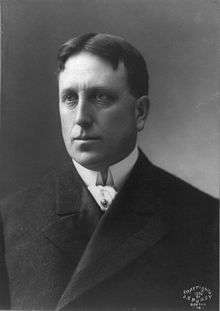 |
.jpg) | |
| CEO of Hisgen Brothers from Massachusetts (1888–1927) |
Newspaper Editor from Georgia |
Former U.S. Representative for Alabama's 7th District (1895–1899) |
Attorney at Law from New York |
Former U.S. Representative for New York's 11th District (1903–1907) |
Former U.S. Representative for Nebraska's 1st District (1891–1895) |
| Delegates: 831 | Delegates: 213 | Delegates: 200 | Delegates: 71 NW: Before 2nd Ballot |
Delegates: 49 DTBN |
Delegates: 0 NR |
| [31] | [31] | [31] | [31] | [31] | [31] |
Disappointed with his performance in the 1904 Democratic presidential nomination campaign, and disillusioned as to his chances of successfully attaining it in 1908, William Randolph Hearst decided to run instead on the ticket of a third party of his own making. Originally borne from the Municipal Ownership League, a vehicle for Hearst's ultimately unsuccessful bid for the mayoralty of New York in 1905, it was Hearst's intention to fuse it with the remnants of the Populist Party led by Thomas Watson, a former Representative from Georgia who had been its presidential nominee in 1904. However, these intentions were dashed when every candidate that the Independence Party put forth in elections held in New York was elected except Hearst himself, despite an endorsement by the Democratic Party. Devastated, Hearst declared his intention never again to be a candidate.
While Hearst would no longer be the nominee, he fully intended to exercise influence at Independence Party's convention; the platform itself was in large part a statement of his own views. With its candidates nominated, the party's purpose was changed from being a path for Hearst's presidential ambitions to being an instrument of his wrath. Through the influence of his papers and generous financial donations, Hearst hoped that the Independence ticket would draw away votes from William Jennings Bryan and lead to his defeat against Taft, a personal vendetta for Bryan failing to support his own bid for the Presidency in 1904.
| Presidential Ballot | |||
| 1st | 2nd | 3rd | |
|---|---|---|---|
| Thomas L. Hisgen | 396 | 590 | 831 |
| John T. Graves | 213 | 189 | 7 |
| Milford W. Howard | 200 | 109 | 38 |
| Reuben R. Lyon | 71 | 0 | 0 |
| William R. Hearst | 49 | 49 | 2 |
General election
Campaign

With the Free Silver issue no longer dominant, Bryan campaigned on a progressive platform attacking "government by privilege." His campaign slogan, "Shall the People Rule?", was featured on numerous posters and campaign memorabilia. However, Taft undercut Bryan's liberal support by accepting some of his reformist ideas, and Roosevelt's progressive policies blurred the distinctions between the parties. Republicans also used the slogan "Vote for Taft now, you can vote for Bryan anytime," a sarcastic reference to Bryan's two failed previous presidential campaigns.
The Socialist candidate, Eugene Debs, embarked on an ambitious whistle-stop tour aboard a train nicknamed the Red Special, giving speeches regarding the Socialist cause across the country. The exertion of the tour exhausted Debs, and at certain points his brother Theodore - who bore a great resemblance to Eugene - substituted for him to allow the candidate to rest.[33]
Businessmen continued to support the Republican Party, and Bryan failed to secure the support of labor. As a result, Bryan ended up with the worst of his three defeats in the national popular vote. He lost almost all the northern states to Taft and the popular vote by 8 percentage points.
This would be Bryan's last campaign for the presidency, although he would remain a popular figure within the Democratic Party and in 1912 would play a key role in securing the presidential nomination for Woodrow Wilson. Charles W. Bryan, William's brother, would become the (losing) Democratic nominee for Vice President in 1924.
Results
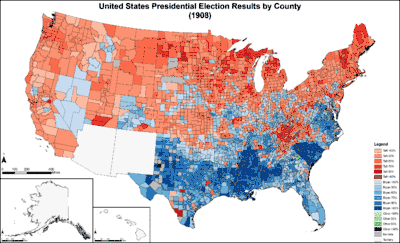
Forty-six states participated, as Oklahoma had joined the Union less than a year before. Bryan won forty-eight counties in the new state of Oklahoma. The most important increase in number of counties carried by Bryan was in the West South Central section, in part due to the vote of newly admitted Oklahoma.[35]
Of the 2,858 counties making returns, Taft won in 1,494 (52.27%) while Bryan carried 1,355 (47.41%). Nine (0.31%) counties recorded more votes cast for "Other(s)" than either of the two-party candidates, whilst twenty-eight counties (0.97%) recorded zero votes due to being inhabited either by Native Americans who would not gain full citizenship for sixteen years, or by disenfranchised southern African-Americans. Taft had a majority in 1,325 counties while Bryan had a majority in 1,204 counties.
By carrying 1,355 counties, Bryan won more counties than he had in 1900 (1,340), but he did not reach or surpass the number of counties he had won in 1896 (1,559). While Bryan won more counties than McKinley in 1896, Bryan failed to carry more counties than the Republican candidate in 1900 or 1904. Compared with his strength in previous elections, however, Bryan carried 69 counties in 1908 which had not been Democratic in either 1896 or 1900.[36]
Bryan increased the area carried by Democrats in every part of the country except New England and the South. He doubled the number of Democratic counties in Wisconsin and won more counties in Indiana than were carried by plurality vote by the Democrats in any election in the Fourth Party System except 1912. He made decided gains in Missouri and in his home state of Nebraska,[35] besides achieving notable victories in Colorado and Nevada. However, in four Western states (Washington, Oregon, Wyoming, and North Dakota), there was not one Democratic county. This was true likewise of Michigan, Delaware, and each of the New England states.
The total vote increased greatly, by more than a million vis-à-vis 1904. Each party shared in the increase, but whereas Taft had nearly fifty thousand more than Theodore Roosevelt, Bryan had nearly 1,500,000 more votes than Alton Parker had garnered, and more than in either of his previous campaigns.
It was noticeable that the "other" vote was only about seven thousand less than four years earlier. The "other" vote was a plurality in nine counties in the states of Georgia and Texas.
The size of the vote cast for the defeated Bryan in 1908 is clear evidence of perhaps the most striking feature of the American presidential vote. In this third attempt at the presidency, and in an election following one in which the nominee of his party polled only five million votes, Bryan had heavy support in every section of the country, and in every state. Moreover, nearly two-thirds of the vote cast for Bryan was from the fifteen states of the (Northeastern) Mid-Atlantic, East North Central, and West North Central sections, in which the Democratic candidate carried only one state (Nebraska).
Despite all conclusions as to predominant sentiment in the different sections and its economic, social, and political causes, there was a national vote cast for Bryan, and it was urban as well as rural; it was eastern, western, southern, and northern. Everywhere the Democratic Party was the minority party, and it was not hopeless, nor was it helpless. It was the agency for the expression of the opposition of almost six and a half million voters.[36]
This was the last election in which the Republicans won California, Idaho, Kansas, Missouri, Montana, New Hampshire, North Dakota, Ohio and Wyoming until 1920.
As of 2017, this is the last of only two elections when Kansas[37] and Nebraska[38] have not voted for the same candidate.[lower-alpha 1] The election of 1908 was the last election in which a Republican won the presidency without winning Nebraska. It is also the last election in which a Republican won without Nevada and/or Colorado until 2016.
| Presidential candidate | Party | Home state | Popular vote | Electoral vote |
Running mate | |||
|---|---|---|---|---|---|---|---|---|
| Count | Percentage | Vice-presidential candidate | Home state | Electoral vote | ||||
| William Howard Taft | Republican | Ohio | 7,678,335 | 51.57% | 321 | James S. Sherman | New York | 321 |
| William Jennings Bryan | Democratic | Nebraska | 6,408,979 | 43.04% | 162 | John W. Kern | Indiana | 162 |
| Eugene V. Debs | Socialist | Indiana | 420,852 | 2.83% | 0 | Benjamin Hanford | New York | 0 |
| Eugene W. Chafin | Prohibition | Illinois | 254,087 | 1.71% | 0 | Aaron S. Watkins | Ohio | 0 |
| Thomas L. Hisgen | Independence | Massachusetts | 82,574 | 0.55% | 0 | John Temple Graves | Georgia | 0 |
| Thomas E. Watson | Populist | Georgia | 28,862 | 0.19% | 0 | Samuel Williams | Indiana | 0 |
| August Gillhaus | Socialist Labor | New York | 14,031 | 0.09% | 0 | Donald L. Munro | Virginia | 0 |
| Other | 1,519 | 0.01% | — | Other | — | |||
| Total | 14,889,239 | 100% | 483 | 483 | ||||
| Needed to win | 242 | 242 | ||||||
Source (Popular Vote): Leip, David. "1908 Presidential Election Results". Dave Leip's Atlas of U.S. Presidential Elections. Retrieved September 10, 2012.
Source (Electoral Vote): "Electoral College Box Scores 1789–1996". National Archives and Records Administration. Retrieved July 31, 2005.
Geography of results

 Results by county, shaded according to winning candidate's percentage of the vote
Results by county, shaded according to winning candidate's percentage of the vote
Cartographic gallery
 Map of presidential election results by county
Map of presidential election results by county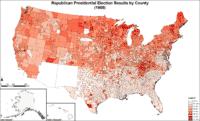 Map of Republican presidential election results by county
Map of Republican presidential election results by county Map of Democratic presidential election results by county
Map of Democratic presidential election results by county Map of "other" presidential election results by county
Map of "other" presidential election results by county Cartogram of presidential election results by county
Cartogram of presidential election results by county Cartogram of Republican presidential election results by county
Cartogram of Republican presidential election results by county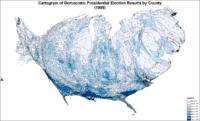 Cartogram of Democratic presidential election results by county
Cartogram of Democratic presidential election results by county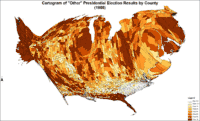 Cartogram of "other" presidential election results by county
Cartogram of "other" presidential election results by county
Results by state
| States won by Taft/Sherman |
| States won by Bryan/Kern |
| William Howard Taft Republican |
William Jennings Bryan Democratic |
Eugene V. Debs Socialist |
Eugene Chafin Prohibition |
Thomas Hisgen Independence |
Thomas Watson Populist |
August Gillhaus Socialist Labor |
Margin | State Total | ||||||||||||||||||
|---|---|---|---|---|---|---|---|---|---|---|---|---|---|---|---|---|---|---|---|---|---|---|---|---|---|---|
| State | electoral votes |
# | % | electoral votes |
# | % | electoral votes |
# | % | electoral votes |
# | % | electoral votes |
# | % | electoral votes |
# | % | electoral votes |
# | % | electoral votes |
# | % | # | |
| Alabama | 11 | 25,561 | 24.31 | - | 74,391 | 70.75 | 11 | 1,450 | 1.38 | - | 690 | 0.66 | - | 497 | 0.47 | - | 1,576 | 1.50 | - | - | - | - | -48,830 | -46.44 | 105,152 | AL |
| Arkansas | 9 | 56,624 | 37.30 | - | 87,015 | 57.31 | 9 | 5,842 | 3.85 | - | 1,026 | 0.68 | - | 289 | 0.19 | - | 1,026 | 0.68 | - | - | - | - | -30,391 | -20.02 | 151,822 | AR |
| California | 10 | 214,398 | 55.46 | 10 | 127,492 | 32.98 | - | 28,659 | 7.41 | - | 11,770 | 3.04 | - | 4,278 | 1.11 | - | - | - | - | - | - | - | 86,906 | 22.48 | 386,597 | CA |
| Colorado | 5 | 123,693 | 46.88 | - | 126,644 | 48.00 | 5 | 7,960 | 3.02 | - | 5,559 | 2.11 | - | - | - | - | - | - | - | - | - | - | -2,951 | -1.12 | 263,858 | CO |
| Connecticut | 7 | 112,915 | 59.43 | 7 | 68,255 | 35.92 | - | 5,113 | 2.69 | - | 2,380 | 1.25 | - | 728 | 0.38 | - | - | - | - | 608 | 0.32 | - | 44,660 | 23.50 | 190,003 | CT |
| Delaware | 3 | 25,014 | 52.10 | 3 | 22,055 | 45.94 | - | 239 | 0.50 | - | 670 | 1.40 | - | 29 | 0.06 | - | - | - | - | - | - | - | 2,959 | 6.16 | 48,007 | DE |
| Florida | 5 | 10,654 | 21.58 | - | 31,104 | 63.01 | 5 | 3,747 | 7.59 | - | 1,356 | 2.75 | - | 553 | 1.12 | - | 1,946 | 3.94 | - | - | - | - | -20,450 | -41.43 | 49,360 | FL |
| Georgia | 13 | 41,355 | 31.21 | - | 72,350 | 54.60 | 13 | 584 | 0.44 | - | 1,452 | 1.10 | - | 76 | 0.06 | - | 16,687 | 12.59 | - | - | - | - | -30,995 | -23.39 | 132,504 | GA |
| Idaho | 3 | 52,621 | 54.09 | 3 | 36,162 | 37.17 | - | 6,400 | 6.58 | - | 1,986 | 2.04 | - | 124 | 0.13 | - | - | - | - | - | - | - | 16,459 | 16.92 | 97,293 | ID |
| Illinois | 27 | 629,932 | 54.53 | 27 | 450,810 | 39.02 | - | 34,711 | 3.00 | - | 29,364 | 2.54 | - | 7,724 | 0.67 | - | 633 | 0.05 | - | 1,680 | 0.15 | - | 179,122 | 15.50 | 1,155,254 | IL |
| Indiana | 15 | 348,993 | 48.40 | 15 | 338,262 | 46.91 | - | 13,476 | 1.87 | - | 18,045 | 2.50 | - | 514 | 0.07 | - | 1,193 | 0.17 | - | 643 | 0.09 | - | 10,731 | 1.49 | 721,126 | IN |
| Iowa | 13 | 275,209 | 55.62 | 13 | 200,771 | 40.58 | - | 8,287 | 1.67 | - | 9,837 | 1.99 | - | 404 | 0.08 | - | 261 | 0.05 | - | - | - | - | 74,438 | 15.05 | 494,769 | IA |
| Kansas | 10 | 197,216 | 52.46 | 10 | 161,209 | 42.88 | - | 12,420 | 3.30 | - | 5,033 | 1.34 | - | 68 | 0.02 | - | - | - | - | - | - | - | 36,007 | 9.58 | 375,946 | KS |
| Kentucky | 13 | 235,711 | 48.03 | - | 244,092 | 49.74 | 13 | 4,093 | 0.83 | - | 5,885 | 1.20 | - | 200 | 0.04 | - | 333 | 0.07 | - | 405 | 0.08 | - | -8,381 | -1.71 | 490,719 | KY |
| Louisiana | 9 | 8,958 | 11.93 | - | 63,568 | 84.63 | 9 | 2,514 | 3.35 | - | - | - | - | 77 | 0.10 | - | - | - | - | - | - | - | -54,610 | -72.70 | 75,117 | LA |
| Maine | 6 | 66,987 | 63.00 | 6 | 35,403 | 33.29 | - | 1,758 | 1.65 | - | 1,487 | 1.40 | - | 700 | 0.66 | - | 1 | 0.00 | - | - | - | - | 31,584 | 29.70 | 106,336 | ME |
| Maryland | 8 | 116,513 | 48.85 | 2 | 115,908 | 48.59 | 6 | 2,323 | 0.97 | - | 3,302 | 1.38 | - | 485 | 0.20 | - | - | - | - | - | - | - | 605 | 0.25 | 238,531 | MD |
| Massachusetts | 16 | 265,966 | 58.21 | 16 | 155,543 | 34.04 | - | 10,779 | 2.36 | - | 4,374 | 0.96 | - | 19,237 | 4.21 | - | - | - | - | 1,011 | 0.22 | - | 110,423 | 24.17 | 456,919 | MA |
| Michigan | 14 | 335,580 | 61.93 | 14 | 175,771 | 32.44 | - | 11,586 | 2.14 | - | 16,974 | 3.13 | - | 760 | 0.14 | - | - | - | - | 1,096 | 0.20 | - | 159,809 | 29.49 | 541,830 | MI |
| Minnesota | 11 | 195,843 | 59.11 | 11 | 109,401 | 33.02 | - | 14,527 | 4.38 | - | 11,107 | 3.35 | - | 426 | 0.13 | - | - | - | - | - | - | - | 86,442 | 26.09 | 331,304 | MN |
| Mississippi | 10 | 4,363 | 6.52 | - | 60,287 | 90.11 | 10 | 978 | 1.46 | - | - | - | - | - | - | - | 1,276 | 1.91 | - | - | - | - | -55,924 | -83.59 | 66,904 | MS |
| Missouri | 18 | 347,203 | 48.50 | 18 | 346,574 | 48.41 | - | 15,431 | 2.16 | - | 4,284 | 0.60 | - | 402 | 0.06 | - | 1,165 | 0.16 | - | 868 | 0.12 | - | 629 | 0.09 | 715,927 | MO |
| Montana | 3 | 32,333 | 46.98 | 3 | 29,326 | 42.61 | - | 5,855 | 8.51 | - | 827 | 1.20 | - | 481 | 0.70 | - | - | - | - | - | - | - | 3,007 | 4.37 | 68,822 | MT |
| Nebraska | 8 | 126,997 | 47.60 | - | 131,099 | 49.14 | 8 | 3,524 | 1.32 | - | 5,179 | 1.94 | - | - | - | - | - | - | - | - | - | - | -4,102 | -1.54 | 266,799 | NE |
| Nevada | 3 | 10,775 | 43.93 | - | 11,212 | 45.71 | 3 | 2,103 | 8.57 | - | - | - | - | 436 | 1.78 | - | - | - | - | - | - | - | -437 | -1.78 | 24,526 | NV |
| New Hampshire | 4 | 53,149 | 59.32 | 4 | 33,655 | 37.56 | - | 1,299 | 1.45 | - | 905 | 1.01 | - | 584 | 0.65 | - | - | - | - | - | - | - | 19,494 | 21.76 | 89,600 | NH |
| New Jersey | 12 | 265,298 | 56.80 | 12 | 182,522 | 39.07 | - | 10,249 | 2.19 | - | 4,930 | 1.06 | - | 2,916 | 0.62 | - | - | - | - | 1,196 | 0.26 | - | 82,776 | 17.72 | 467,111 | NJ |
| New York | 39 | 870,070 | 53.11 | 39 | 667,468 | 40.74 | - | 38,451 | 2.35 | - | 22,667 | 1.38 | - | 35,817 | 2.19 | - | - | - | - | 3,877 | 0.24 | - | 202,602 | 12.37 | 1,638,350 | NY |
| North Carolina | 12 | 114,887 | 45.49 | - | 136,928 | 54.22 | 12 | 372 | 0.15 | - | 354 | 0.14 | - | - | - | - | - | - | - | - | - | - | -22,041 | -8.73 | 252,554 | NC |
| North Dakota | 4 | 57,680 | 61.02 | 4 | 32,885 | 34.79 | - | 2,421 | 2.56 | - | 1,496 | 1.58 | - | 43 | 0.05 | - | - | - | - | - | - | - | 24,795 | 26.23 | 94,525 | ND |
| Ohio | 23 | 572,312 | 51.03 | 23 | 502,721 | 44.82 | - | 33,795 | 3.01 | - | 11,402 | 1.02 | - | 439 | 0.04 | - | 162 | 0.01 | - | 721 | 0.06 | - | 69,591 | 6.20 | 1,121,552 | OH |
| Oklahoma | 7 | 110,550 | 43.03 | - | 123,907 | 48.22 | 7 | 21,752 | 8.47 | - | - | - | - | 274 | 0.11 | - | 412 | 0.17 | - | - | - | - | -11,889 | -4.66 | 256,917 | OK |
| Oregon | 4 | 62,530 | 56.39 | 4 | 38,049 | 34.31 | - | 7,339 | 6.62 | - | 2,682 | 2.42 | - | 289 | 0.26 | - | - | - | - | 274 | 0.11 | - | 24,481 | 22.08 | 110,889 | OR |
| Pennsylvania | 34 | 745,779 | 58.84 | 34 | 448,782 | 35.41 | - | 33,914 | 2.68 | - | 36,694 | 2.90 | - | 1,057 | 0.08 | - | - | - | - | 1,224 | 0.10 | - | 296,997 | 23.43 | 1,267,450 | PA |
| Rhode Island | 4 | 43,942 | 60.76 | 4 | 24,706 | 34.16 | - | 1,365 | 1.89 | - | 1,016 | 1.40 | - | 1,105 | 1.53 | - | - | - | - | 183 | 0.25 | - | 19,236 | 26.60 | 72,317 | RI |
| South Carolina | 9 | 3,945 | 5.94 | - | 62,288 | 93.84 | 9 | 100 | 0.15 | - | - | - | - | 46 | 0.07 | - | - | - | - | - | - | - | -58,343 | -87.89 | 66,379 | SC |
| South Dakota | 4 | 67,536 | 58.84 | 4 | 40,266 | 35.08 | - | 2,846 | 2.48 | - | 4,039 | 3.52 | - | 88 | 0.08 | - | - | - | - | - | - | - | 27,270 | 23.76 | 114,775 | SD |
| Tennessee | 12 | 117,977 | 45.87 | - | 135,608 | 52.73 | 12 | 1,870 | 0.73 | - | 301 | 0.12 | - | 332 | 0.13 | - | 1,092 | 0.42 | - | - | - | - | -17,631 | -6.86 | 257,180 | TN |
| Texas | 18 | 65,666 | 22.35 | - | 217,302 | 73.97 | 18 | 7,870 | 2.68 | - | 1,634 | 0.56 | - | 115 | 0.04 | - | 994 | 0.34 | - | 176 | 0.06 | - | -151,636 | -51.62 | 293,757 | TX |
| Utah | 3 | 61,028 | 56.19 | 3 | 42,601 | 39.22 | - | 4,895 | 4.51 | - | - | - | - | 87 | 0.08 | - | - | - | - | - | - | - | 18,427 | 16.97 | 108,613 | UT |
| Vermont | 4 | 39,552 | 75.08 | 4 | 11,496 | 21.82 | - | - | - | - | 799 | 1.52 | - | 804 | 1.53 | - | - | - | - | - | - | - | 28,056 | 53.26 | 52,680 | VT |
| Virginia | 12 | 52,572 | 38.36 | - | 82,946 | 60.52 | 12 | 255 | 0.19 | - | 1,111 | 0.81 | - | 51 | 0.04 | - | 105 | 0.08 | - | 25 | 0.02 | - | -30,374 | -22.16 | 137,065 | VA |
| Washington | 5 | 106,062 | 57.68 | 5 | 58,691 | 31.92 | - | 14,177 | 7.71 | - | 4,700 | 2.56 | - | 249 | 0.14 | - | - | - | - | - | - | - | 47,371 | 25.76 | 183,879 | WA |
| West Virginia | 7 | 137,869 | 53.42 | 7 | 111,418 | 43.17 | - | 3,679 | 1.43 | - | 5,139 | 1.99 | - | - | - | - | - | - | - | - | - | - | 26,451 | 10.25 | 258,105 | WV |
| Wisconsin | 13 | 247,747 | 54.52 | 13 | 166,662 | 36.67 | - | 28,147 | 6.19 | - | 11,565 | 2.54 | - | - | - | - | - | - | - | 318 | 0.07 | - | 81,085 | 17.84 | 454,441 | WI |
| Wyoming | 3 | 20,846 | 55.43 | 3 | 14,918 | 39.67 | - | 1,715 | 4.56 | - | 66 | 0.18 | - | 64 | 0.17 | - | - | - | - | - | - | - | 5,928 | 15.76 | 37,609 | WY |
| TOTALS: | 483 | 7,678,335 | 51.57 | 321 | 6,408,979 | 43.04 | 162 | 420,852 | 2.83 | - | 254,087 | 1.71 | - | 82,574 | 0.55 | - | 28,862 | 0.19 | - | 14,031 | 0.09 | - | 1,269,356 | 8.53 | 14,889,239 | US |
Close states
Margin of victory less than 1% (34 electoral votes):
- Missouri, 0.09%
- Maryland, 0.25%
Margin of victory less than 5% (46 electoral votes):
- Colorado, 1.12%
- Indiana, 1.49%
- Nebraska, 1.54%
- Kentucky, 1.71%
- Nevada, 1.78%
- Montana, 4.37%
- Oklahoma, 4.66%
Margin of victory between 5% and 10% (60 electoral votes):
- Delaware, 6.16%
- Tennessee, 6.86%
- Ohio, 6.20%
- North Carolina, 8.73%
- Kansas, 9.58%
Statistics
Counties with Highest Percent of Vote (Republican)
- Leslie County, Kentucky 92.96%
- Unicoi County, Tennessee 92.77%
- Sevier County, Tennessee 91.44%
- Keweenaw County, Michigan 90.56%
- Johnson County, Tennessee 90.21%
Counties with Highest Percent of Vote (Democratic)
- Hampton County, South Carolina 100.00%
- King County, Texas 100.00%
- Garza County, Texas 100.00%
- Loving County, Texas 100.00%
- Wilcox County, Alabama 99.81%
Counties with Highest Percent of Vote (Other)
- Terry County, Texas 100.00%
- Glascock County, Georgia 69.97%
- McDuffie County, Georgia 64.31%
- Lincoln County, Georgia 61.65%
- Oconee County, Georgia 56.21%
Campaign memorabilia
 Taft-Sherman postcard
Taft-Sherman postcard Collier's magazine cover
Collier's magazine cover Humorous postcard
Humorous postcard- John Johnson ribbon
 Taft-Sherman postcard with U.S. Capitol
Taft-Sherman postcard with U.S. Capitol Bryan-Kern postcard with U.S. Capitol
Bryan-Kern postcard with U.S. Capitol
See also
Notes
- The other was in 1892 when Kansas voted for Populist James B. Weaver and Nebraska for Republican Benjamin Harrison
References
- "Voter Turnout in Presidential Elections". The American Presidency Project. UC Santa Barbara.
- https://timesmachine.nytimes.com/timesmachine/1908/05/10/104724895.pdf
- https://timesmachine.nytimes.com/timesmachine/1908/06/07/104804921.html?pageNumber=2
- https://timesmachine.nytimes.com/timesmachine/1908/06/10/104729923.pdf
- https://timesmachine.nytimes.com/timesmachine/1908/06/12/104730451.pdf
- https://timesmachine.nytimes.com/timesmachine/1908/06/13/104805494.pdf
- https://timesmachine.nytimes.com/timesmachine/1908/06/11/105006613.pdf
- Bain, Richard C.; Parris, Judith H. Convention Decisions and Voting Records. p. 174. ISBN 0-8157-0768-1.
- "Official report of the proceedings of the fourteenth Republican National Convention, held in Chicago, Illinois, June 16, 17, 18 and 19, 1908". Archive.org. Retrieved August 18, 2016.
- "Official report of the proceedings of the fourteenth Republican National Convention, held in Chicago, Illinois, June 16, 17, 18 and 19, 1908". Archive.org. Retrieved August 18, 2016.
- https://timesmachine.nytimes.com/timesmachine/1908/06/08/104805265.pdf
- "HarpWeek | Elections | The Democratic Nomination". Elections.harpweek.com. Retrieved September 23, 2017.
- https://timesmachine.nytimes.com/timesmachine/1906/06/11/101781931.pdf
- https://timesmachine.nytimes.com/timesmachine/1906/08/17/101794083.pdf
- https://timesmachine.nytimes.com/timesmachine/1906/12/08/101852309.pdf
- https://timesmachine.nytimes.com/timesmachine/1905/01/04/102419089.pdf
- https://timesmachine.nytimes.com/timesmachine/1906/07/26/101790124.pdf
- https://timesmachine.nytimes.com/timesmachine/1907/02/10/106739469.pdf
- https://timesmachine.nytimes.com/timesmachine/1907/03/16/106110680.pdf
- https://timesmachine.nytimes.com/timesmachine/1907/04/15/106707137.pdf
- https://timesmachine.nytimes.com/timesmachine/1907/11/24/106768999.pdf
- https://timesmachine.nytimes.com/timesmachine/1908/03/30/104721255.pdf
- https://timesmachine.nytimes.com/timesmachine/1908/04/03/104851342.pdf
- https://timesmachine.nytimes.com/timesmachine/1908/04/04/104721909.pdf
- https://archive.org/details/1908soconAMerged
- https://timesmachine.nytimes.com/timesmachine/1908/07/03/104736757.pdf
- https://timesmachine.nytimes.com/timesmachine/1908/07/05/104737233.pdf
- https://timesmachine.nytimes.com/timesmachine/1908/07/06/104737630.pdf
- https://timesmachine.nytimes.com/timesmachine/1908/07/09/105007294.pdf
- https://timesmachine.nytimes.com/timesmachine/1908/07/17/104739539.pdf
- https://timesmachine.nytimes.com/timesmachine/1908/07/29/104743252.pdf
- "HISGEN AND GRAVES NEW PARTY TICKET – The Independence Convention Makes Its Choice in Early Morning. BRYAN'S NAME WAS HISSED Small Riot Followed Attempts to Nominate Him and His Sponsor Was Threatened by Delegates. HISGEN AND GRAVES NEW PARTY TICKET" (PDF). The New York Times. July 29, 1908. Retrieved August 18, 2016.
- Morgan, H. Wayne (1958). ""Red Special": Eugene V. Debs and the Campaign of 1908". Indiana Magazine of History. 54 (3): 211–236. Retrieved March 24, 2017.
- The Presidential Vote, 1896–1932 – Google Books. Stanford University Press. 1934. Retrieved August 12, 2014.
- The Presidential Vote, 1896–1932, Edgar E. Robinson, pg. 13
- The Presidential Vote, 1896–1932, Edgar E. Robinson, pg. 14
- Counting the Votes; Kansas
- Counting the Votes; Nebraska
- "1908 Presidential General Election Data – National". Uselectionatlas.org. Retrieved April 26, 2013.
Further reading
- Daniels, Josephus (July–December 1908). "Mr. Bryan's Third Campaign". Review of Reviews. Review of Reviews. 38: 423–31.
- Tim Davenport, "Red Special Across America," The Debs Project blog, June 23, 2019. —Complete list of Debs tour stops
- Korzi, Michael J., "William Howard Taft, the 1908 Election, and the Future of the American Presidency," Congress and the Presidency, 43 (May–August 2016), 227–54.
External links
| Wikimedia Commons has media related to United States presidential election, 1908. |
- United States presidential election of 1908 at the Encyclopædia Britannica
- Presidential Election of 1908: A Resource Guide from the Library of Congress
- 1908 popular vote by counties
- The Republican Campaign Textbook 1908
- How close was the 1908 election? — Michael Sheppard, Massachusetts Institute of Technology
- Election of 1908 in Counting the Votes
